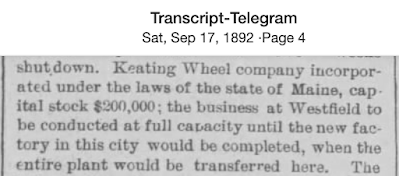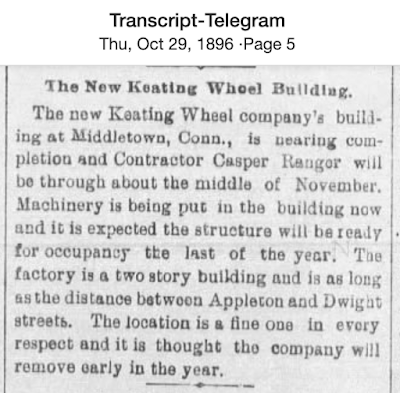Some companies may have had a short-lived history, but produced high-quality products during their years of operation. This was the case with the Keating Wheel Company of Holyoke, Massachusetts.
The Keating Wheel Company was organized in Westfield, Massachusetts, in September 1890. Robert M. Keating was a designer and mechanic who had worked for the Warwick bicycle factory located in the same city. He was a native of Springfield, Mass., and was 23 years old when he started his business.
Mr. Keating was awarded patents for the bicycle's spring frame, a unique design in the industry. He named his new bicycle the Keating Superior. The business established itself in the former Westfield Whip factory building, and following seven months of acquisition and equipment setup, production began in May 1891.
Two months after beginning production, the company was purchased by Holyoke interests. M. H. Whitcomb, one of the manufacturer's key investors, planned to build a new brick factory on land he owned on the south side of Dwight Street. The 230' long plant, 80' and 50' wide, would follow along the west side of the first-level canal. The 1895 Sanborn map below shows the location.
The Westfield plant continued production until late in 1891, when the company's 30 Dwight Street building was completed. The factory was furnished with the best-made equipment.
What began as a capital raising effort of $200,000 increased to $250,000 in 1892 and $350,000 in 1893, with the potential to authorize $500,000 soon thereafter.
The company continued to tout its large orders for bicycles in news articles, and at times, refused new orders due to working at full capacity. At times, it was late in fulfilling orders; however, news articles expressed a positive outlook.
In 1892, the company produced bicycles of three weights: 37 pounds, 32 pounds, and a woman's 32-pound model. In 1893, the company introduced a 30-pound women's bicycle to its product line.
Financial stresses were taking place along the company's path. An auction sale of the company's assets was advertised to occur on October 2, 1893. The secured lender sought to recover the outstanding mortgage balance. There were several postponements of the auction, based on the company's promise to restructure and pay its debts.
During the financial setback of October 1893, Charles D. Rood of Springfield became an investor and became heavily involved in the business's operations.
By January 1894, the company was back in operation and receiving large orders. By April, the plant was running at full capacity. The $30,000 mortgage was paid off in July 1894.
In 1895, the factory added lighter-weight bicycles to its inventory. Bicycles were designed and produced weighing as little as 19 pounds, which was nearly half the weight of those manufactured three years prior.
In May 1895, reports surfaced that Keating Wheel was one of several companies that fell victim to a financial swindle, which netted the culprits $500,000. Mr. Crompton, the respondent at the company, indicated that it was the first he had heard of it.
In January 1896, discussions arose about the company relocating to Florence, Massachusetts, and Meriden, Connecticut. Two months later, there were rumors of a move to Pittsfield, Mass., and Middletown, Connecticut.
In May 1896, Keating Wheel renewed its lease at its existing location for an additional year ending December 31, 1897.
A month later, in June 1896, it was announced that Casper Ranger Construction would build a new plant for Keating Wheel in Middletown. On September 14, 1897, the company relocated and began operations in Connecticut. The Whitcomb building later became a part of the Skinner Silk Mills.
All was not well with the Keating company. It could not maintain its payments to the town, which advanced the $100,000 loan to finance the factory building. A receiver was appointed by the Middletown Superior Court judge. In 1900, the company shuttered, marking the end of the Keating Wheel Company. The receiver sold the factory in 1901.
Mr. Keating continued to work on his inventions until he died in 1922. He had a controlling patent on motorcycles and invented the Tessier Brothers lunchroom chairs made in Northampton, Mass. He was working on a silent flush valve, which was used by the cities of Holyoke and Springfield.
Citations:
Newspapers.com (paid subscription): Citations: Holyoke (Massachusetts) Transcript & Transcript-Telegram; Springfield (Massachusetts) Republican; Waterbury (Connecticut) Democrat; New Haven (Connecticut) Journal-Courier Journal; publication dates and pages are shown.
Price & Lee City Directories, Holyoke, Massachusetts, Holyoke Public Library.
Sanborn Fire Insurance Map from Holyoke, Hampden County, Massachusetts (1895)




















































































No comments:
Post a Comment